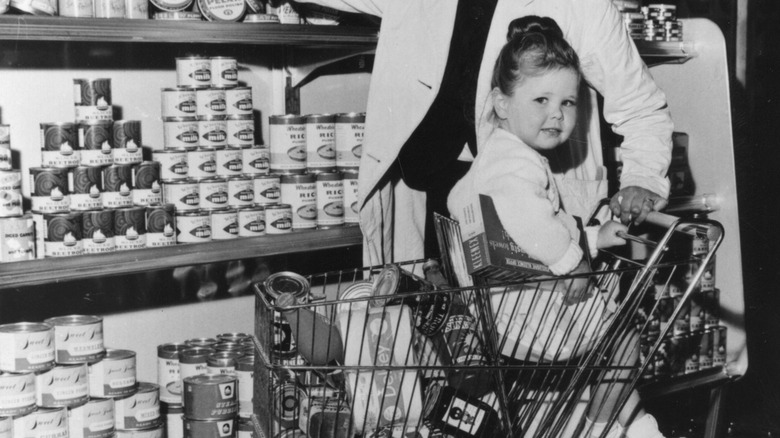The High-Tech 1940s Grocery Cart Innovation That Never Took Off
Of all the things that take up our daily brain space, grocery carts must poll near the bottom. Sure, our kids may get excited to ride the ones that have steering wheels and are designed to look like buses or tractors. The average adult, however, likely views a shopping cart as nothing more than a grocery collector someone left in their parking spot. And yet, if the carts were to one day disappear, we would feel as though we'd lost something important. Wouldn't we?
The shopping cart is a relatively recent creation that coincided with the arrival of the supermarket. Invented in the 1930s by Oklahoman entrepreneur and supermarket chain owner Sylvan Goldman, the grocery store cart became a model for stores across the nation. They showed just how efficient and practical supermarket shopping could be, numbering the days of the mom-and-pop corner grocery. The supermarket phenomenon had arrived and the shopping cart helped it to thrive (via The Oklahoma Historical Society).
Shopping carts were not without their own evolution, however. Sylvan Goldman may have invented the shopping cart, but it was Orla E. Watson who perfected it, per the Smithsonian Institution.
Orla Watson's power lift cart
Orla E. Watson was an engineer from Kansas City, Missouri who saw a problem with the original shopping carts. The carts developed by Sylvan Goldman were bulky, difficult to store, and required assembly in order to be used. So, in 1946, Watson created what he called the Nesting Cart. He engineered both the child seating area we all know and love and added the swinging panel to the back of the cart which allows them to nest inside one another in a telescoping line. This is now the universally accepted way of storing shopping carts (via The Takeout).
However, Watson had another shopping cart innovation that, while amazingly high-tech for the 1940s, failed to take off with consumers. According to the Smithsonian Institution, Watson's concept was called the power lift cart. Installed on a two-basket cart, the lifting mechanism would lift the lower basket to counter height while simultaneously lifting the upper basket out of the cashier's way. The power lift cart was developed before the time of automatic conveyor belts and was intended to make unloading and reloading produce far easier.
Watson launched the power lift in 1947 but soon discontinued it owing to a lack of interest from the wider market and Watson's own desire to perfect the telescoping nesting cart. What kind of high-tech shopping mechanics would we have today if the power lift had caught on way back in the 1940s? It's an interesting thing to ponder.

